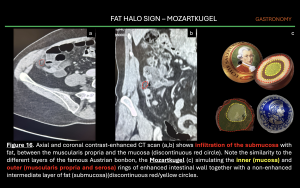Vienna has a rich culinary tradition, famous for dishes such as Wiener Schnitzel or Apfelstrudel, which combine influences from the Austro-Hungarian Empire, a culinary experience that evokes some of these classic radiological signs. In Vienna, where gastronomic culture is deeply appreciated, one could draw a parallel between the radiologist's ability to ‘read’ the occult and its analogy with some of the city's well-known dishes.
An attempt is made to classify these signs on the basis of three fundamental pillars that every self-respecting lover/tourist should enjoy: souvenirs, experiences and gastronomy.
The most emblematic radiological signs and their Austrian reference depending on which souvenirs to buy could be (among many others):
- Snow globe. A world-famous souvenir, where magical snow gently falls on the enchanting scenes inside. As each one is still made by hand, each snow globe is as unique as a snowflake. The radiological sign that evokes this fantastic souvenir is the snowball sign.
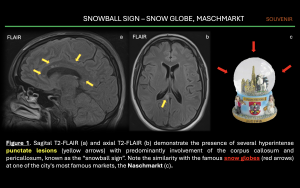
- Porzellanmanufaktur augarten. Ceramics is an art that seems to be born of alchemy itself: a dance between earth, water, fire and air. In each piece, there is hidden a testimony of patience and love for the essential. It is the art of moulding clay, which in human hands ceases to be simply earth and becomes poetry, something the Austrians know very well. A classic finding that evokes ceramics is the gallbladder (porcelain gallbladder), which with its peripheral calcifications emulates this material that is so exquisite in Austrian culture.
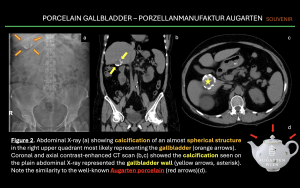
- Stroh: Drinking rum (p.e. Stroh which is a classic product of Austrian culture) and sharing is like igniting a spark of camaraderie. Its taste, warm and bold, invites laughter, spontaneous stories and the bonds that are strengthened between friends. It is a ritual where the spirit of rum not only warms the body, but also the soul, creating magical moments. A classic sign is the water bottle sign (everyone can fill it with whatever they want).

Some of the most extraordinary experiences could be:
- Prater Viena: Riding a Ferris wheel at the Vienna Prater is like letting time stand still for a moment. It is a feeling of suspended calm, as if for a moment you are floating between earth and sky, admiring the beauty of the Austrian countryside. A sign that can be likened to this is the whirlpool sign.
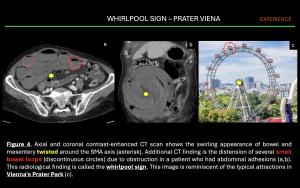
- Der Kuss, Gustav Klimt. Giving a kiss is like a moment frozen in time, where everything condenses into warmth, connection and the spark of the present. It is the language of the soul that needs no words, a shared heartbeat that unites hearts and awakens deep emotions. We don't know if Gustav Klimt wanted to convey this, but a sign that could be correlated is the kissing ovaries sign, in some described diseases like endometriosis.
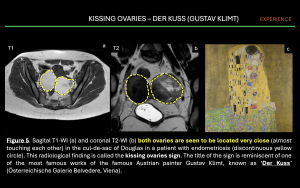
Some radiological findings that resemble the Austrian gastronomy are:
- Baguette Viennoise. Eating vienna bread is like biting into a soft, delicate cloud. Its spongy, slightly sweet texture caresses the palate, while its tenderness melts with every bite. It is a simple but pleasurable sensation, evoking warmth and comfort. The breadcrumb pattern is seen in obstructive bowel disorders, described as small bowel faeces sign.
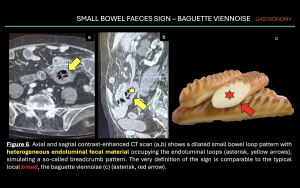
- Frittatensupe. Sipping a hot soup is like wrapping the body in a blanket of warmth and comfort. Each sip is comforting, while the steam caresses the face and the nuanced taste awakens the senses, just like drinking a delicious bowl of frittatensupe. A radiological sign described with similar characteristics could be the linguine sign (intracapsular rupture of a breast implant).

- Wiener Schnitzel. How could we not talk about one of the most famous dishes in Austrian cuisine? This dish bears a striking resemblance to the radiological sign described as the pancake vertebra sign.
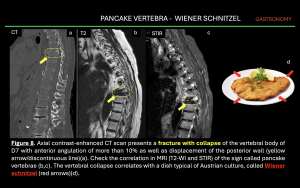
- Speckknödeln. Eating this dish (bacon meatballs) is like a party in your mouth, where meat, spices and sauce compete for the limelight. This sign is reminiscent of the one described in literature as the floating balls sign. This sign can also be related to another typical dessert of Austrian gastronomy, known as Krapfen.
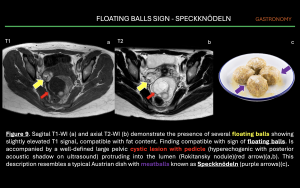
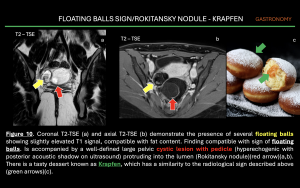
- Austrian Coffee. Who doesn't like a good cup of coffee in the morning? Having a cup of coffee is like giving your soul a hug. The first sip awakens the senses, releasing a comforting warmth that sweeps through the body. The austrians know this very well. This product can be perfectly related to sigma volvulus, known as the coffee bean sign.
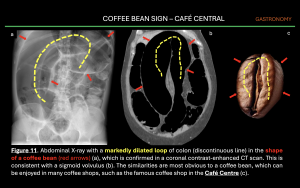
- Linzer torte. There is always time for dessert. Especially if it is a national dessert like Linzer torte. Its presentation and pattern resembles the usual interstitial pneumonia pattern described in idiopathic pulmonary fibrosis.

- Kipferl. This traditional yeast roll is rolled and shaped into a crescent before baking. Its morphology is similar to the air crescent sign, which describes the crescent of gas between an intracavity mass and the cavity wall.
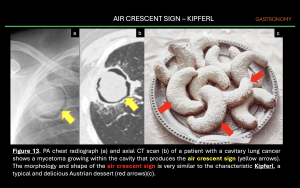
- Apfelstrudel / Sacher Torte. Eating a serving of these tarts is a pleasurable sensation, where the sweet taste and the smooth or creamy texture blend perfectly, creating a comforting and tasty experience. Layering, coverage and filling may simulate a radiological sign known as omental cake (infiltration of omental fat of presumed metastatic spread by soft tissue density material).


- Mozartkugel. Eating a Mozartkugel is an explosion of sweetness and softness. The crunchy or soft exterior melts in the mouth, revealing a creamy filling that melts delicately, leaving a sensation of pleasure. The different layers resemble the fatty infiltration of certain intestinal diseases, a sign known as fat halo sign.
